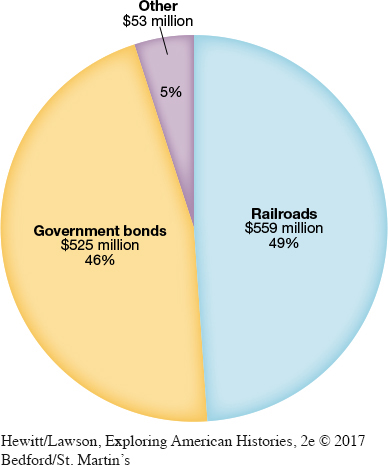Federal Policy and Foreign Investment
Despite the popular association of the West with individual initiative and self-sufficiency, the federal government played a huge role in facilitating the settlement of the West. National lawmakers enacted legislation offering free or cheap land to settlers and to mining, lumber, and railroad companies. The U.S. government also provided subsidies for transporting mail and military supplies, recruited soldiers to subdue the Indians who stood in the way of expansion, and appointed officials to govern the territories.
Along with federal policy, foreign investment helped fuel development of the West. Lacking sufficient funds of its own, the United States turned to Europe to finance the sale of public bonds and private securities. European firms also invested in American mines, with the British leading the way. In 1872 an Englishman wrote that mines in Nevada were “more British than American.” The development of the western cattle range—the symbol of the American frontier and the heroic cowboy—was also funded by overseas financiers. At the height of the cattle boom in the 1880s, British firms supplied some $45 million to underwrite ranch operations. The largest share of money, however, that flowed from Europe to the United States came with the expansion of the railroads, the most important ingredient in opening the West (Figure 15.1).

The transcontinental railroad became the gateway to the West. In 1862 the Republican-led Congress appropriated vast areas of land that railroad companies could use to lay their tracks or sell to raise funds for construction. The Central Pacific Company built from west to east, starting in Sacramento, California. The construction project attracted thousands of Chinese railroad workers. From the opposite direction, the Union Pacific Company began laying track in Council Bluffs, Iowa, and hired primarily Irish workers. In May 1869, the Central Pacific and Union Pacific crews met at Promontory Point, Utah. Workmen from the two companies drove a golden spike to complete the connection. For many Americans recovering from four years of civil war and still embroiled in southern reconstruction, the completion of the transcontinental railroad renewed their faith in the nation’s ingenuity and destiny. A wagon train had once taken six to eight weeks to travel across the West. That trip could now be completed by rail in seven days. The railroad allowed both people and goods to move faster and in greater numbers than before. The West was now open not just to rugged pioneers but to anyone who could afford a railroad ticket.

The building of the railroads also provided new business opportunities, albeit more questionable. For example, Union Pacific promoters created a fake construction company called the Crédit Mobilier, which they used to funnel government bond and contract money into their own pockets. They also bribed congressmen to avoid investigation into their sordid dealings. Despite these efforts, in 1872 Congress exposed this corruption.
REVIEW & RELATE
What role did the federal government play in opening the West to settlement and economic exploitation?
Explain the determination of Americans to settle in land west of the Mississippi River despite the challenges the region presented.
Exploring American HistoriesPrinted Page 485
Exploring American Histories Value EditionPrinted Page 356
Chapter Timeline